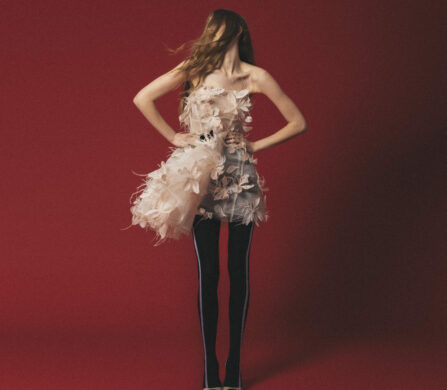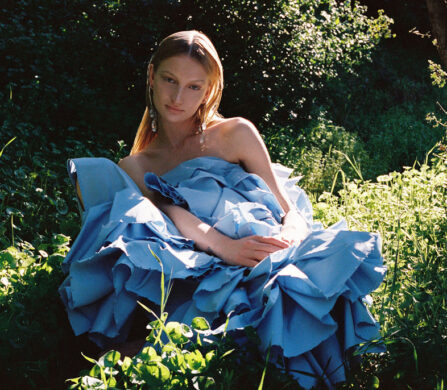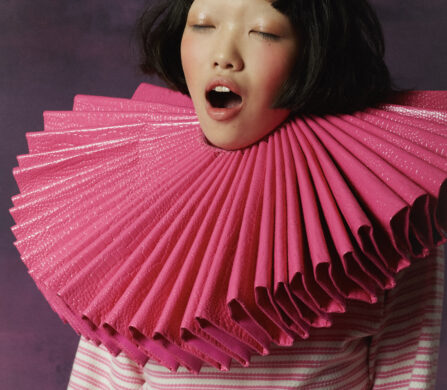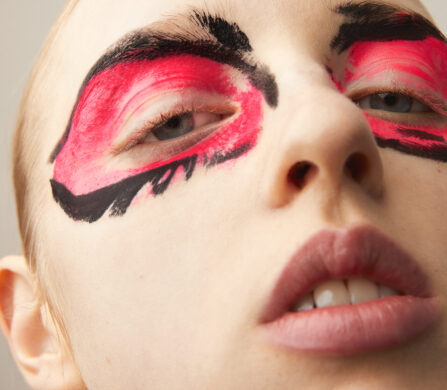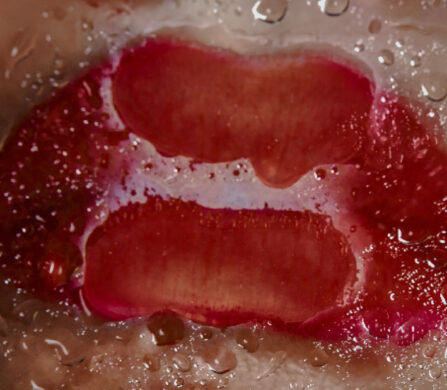Well, this season of haute couture truly was “Access All Areas.” With the COVID-19 pandemic affecting the world, virtually (both literally and figuratively) everyone and everything on the couture calendar was available online.
Sites like the official Federation Haute Couture et Mode, YouTube, The New York Times, Canal+, and even most designers’ websites offered couture coverage. The days were packed with “shows” and almost every thirty minutes for three long days, a designer slot was scheduled — Dior and Chanel, of course, but also many of the smaller houses and newer names. From Balmain, on a Bateau Mouche plowing down the river Seine with the wonderful Yseult setting the soundtrack to Elie Saab offering a short film on nature and the environment. The offering was incredibly broad.
The virtual dose of couture came with its pros and cons. Sometimes, it was almost impossible to make out clothes for tricksy photography or fast “shoot” style imagery. Others, there were no clothes, holding mark for the actual reveal of the collection to be at a later date. On occasions, we were offered an online lookbook to support a fashion film and, at others, we were presented with a written manifesto or press release, again to support the visuals. Some designers chose to speak themselves, either briefly or throughout as commentary.
Still, it was strong. Many houses wished to communicate to this obviously much larger audience, making couture that much more unique. It highlighted couture’s importance and the creative thrill they get out of being involved with it. In the end, these were a fascinating few days that pointed the way to many conversations regarding live shows, online, film, and so on. So, now you’ve read all this preamble what were the standouts from virtual couture and what exactly might you have missed? There were three key threads consistent throughout the thirty plus names: Narrative, Craft, and Sustainability.
Daniel Roseberry is the designer at Schiaparelli and he was the first film on the first day at 10:00 AM Paris time. Simply put, he was in New York unable to fly to Place Vendôme, the Schiaparelli headquarters, so he sat on a park bench and drew his dream collection. It was the truth, it was simple and honest — and it worked. The designs looked beautiful and now we want to know how they will evolve and come to life when he does return to Paris. No real clothes were shown so we did wonder what might be to come.
Narrative
I would select two winners in the Narrative category and give honourable mention to a third. Franck Sorbier was possibly the most beautiful and the most emotional of all the films shown during this season’s couture with its final dedication to a friend lost to COVID-19. It contained a few superb couture outfits and had impressive professionalism about it. Haunting and slow paces until the final extraordinary sequence. But no spoilers, you will have to watch for yourself.
Maurizio Galante worked his magical pieces into the spiral movement of a staircase, endlessly descending and moving. It was really lovely. Finally, Bouchra Jarrar invoked La Nouvelle Vague in her black and white story of twins indoors and outdoors with androgynous pieces that were sharply and well shown off. Some true couture detailing and tailoring was beautifully revealed in closeup. I must however also add a fourth, Antonio Grimaldi. This was shot in an amazing palazzo with the drama of monochrome against orchid shades. The sculptural couture forms created as much drama as the Greek mythology inspiration for the film.
Craft
Before the Chanel show, much play was made in trailers by Loïc Prigent of the petite mains and the ateliers. There are now more of these videos being added online. This was also revealed in the lookbook, although the promotional film itself sped by so fast, tweed, of course, and glitter with a whoosh of taffeta seemed to be the message. Virginie Viard explained it was inspired by Karl’s party nights at Le Palace.
Dior also showed the petite mains as they created the miniature versions of the season’s look inspired by the 1945 Théâtre de la Mode dolls. The main theme was a look at ancient myths and legends with sirens in the woods shimmering and sighing in Dior.
The Paris couturier Julien Fournié told us how his maison works in a beautifully shot film with a narrative to take you through everything from sketch to toile to fittings, to the glorious final pieces. He and the voice-over brought a Hollywood 1950s edge to the story and the clothes were shown in both long shot and closeup. Any leading lady would covet these pieces. Julie de Libran wanted to tell the same story about her workrooms, her craft, and especially the teams involved. Her film was deliciously layered and her voice over conveyed eloquently her passion and dedication to her craft. The clothes were secondary to the atmosphere, but it truly was the couture atmosphere.
Sustainability
Julien Fournié discussed how he never overorders fabric and how carefully thought-through all creative actions at the house are, so waste is kept to the absolute minimum. Julie de Libran mentioned how her lengths of fabric are ends of rolls, short meterage, and strictly limited, so waste and idle fabrics are not part of the creative process.
Yuima Nakazato is a brilliant designer, with an intellectual approach to couture. He collected white shirts from a range of people, discussed what they felt, who they were, and what their fashion requirements were. He then remodelled the shirts and returned them. A simple but ethical idea and also giving back to those outside the elite fashion world. Simply magical.
Aelis, designed by Sofia Crociani, uses upcycling, recycling, and deadstock. This season, her film of dancers was not only beautiful all the way through, seeing the pieces swirling and moving but finished with the dancers viewed from above on a black background. They posed exactly like figures from a Baroque ceiling in arrested motion. Sofia Crociani brings mobility to her pieces with wraps which fly outwards, long pennants of ribbon, or simply draped and folded panels, to then see this motionless was especially lovely. Truly stunning.
Ronald van der Kemp has been a major advocate of sustainable couture for many seasons now. He worked through eight short films each with its own scenario and feeling. Urban, witty, sharp and sexy, soft and multicoloured, each story flirted with silhouette from the full and short to long and layered. The pieced-together dress was less a layered patchwork and more a thousand butterflies fluttering together to form into a dress was spectacular. The final film, whose soundtrack was “Wake up to Love,” featured a series of closeups of people. The camera looking deep into their expressions and feelings. It was almost tangible the emotion between the viewer and these incredible personalities as they gently moved.
There are also some other points to be made, in terms of the variety of narratives and concepts presented. They still relate to the key themes, but with their own twists.
Paris
Christophe Josse presented a full collection of pieces on models but shot at night in the deserted Paris of lockdown. Haunting and romantic, subtle and yet strong, the nighttime palette with shadows and artificial light was in perfect harmony with the white, ivory, cream, chalk white, pale buff, and some hints of deep olive. The textures from rich brushed surfaces to shimmering filigree embroideries at times seemed to emerge from, rather than stand out of the surroundings. It was an ode to Paris, and to couture, the two so inextricably entwined.
Humour
Viktor & Rolf managed to be one hundred percent true to themselves with a witty series of three “lockdown at home” stories of nightgowns and dressing gowns. Emotions were key to each piece but the brilliant touch was the tongue in cheek commentary, which was both a spoof on old-time couture and the kind of short newsreel shown before the main feature. I’m not going to add anything more, simply watch for yourself and smile.
Culture and Craft
Rahul Mishra invoked the beauty of butterflies and his models were like butterflies themselves. He related how he wants to employ people to make these exquisite pieces and offer both conservations of the crafts, and work for these talented people. His vision of masks with quivering butterflies and imaginary 1001 nights gardens combined culture and craft to perfection. Imane Ayissi turned African textiles into layered and pieced collages around the models’ bodies. Stitching together in dozens of different shapes or overlapping like petals forming bodices. Teamed with couture flounces and ruffles, the juxtaposition of two cultures in his masterly hands resulted in perfect harmony.
Showtime
Giambattista Valli, Alexis Mabille, and Stephane Rolland all showed several pieces in formats morphing catwalk, studio, fantasy and reality extremely successfully. In all cases, the clothes were clearly shown and the presentations, although more conventional and “straightforward,” worked well. Both Valli and Mabille have had static exhibition presentations in the past so that the idea of restraint to focus on the clothes made complete sense. Great clothes by strong designers and the styling were impeccable. Nieves Álvarez for Rolland and Joan Smalls for Valli were pitch-perfect in every piece; proving casting certainly can make or break a digital presentation.
Now sit and binge on any of the following — whether on YouTube, the New York Times, or even social media.
words. Tony Glenville
Feature image courtesy of Dior (Jacqueline Lamba , Baudelaire Génie d’amour , © Adagp, Paris, 2020).


Schön! Magazine is now available in print at Amazon,
as ebook download + on any mobile device












